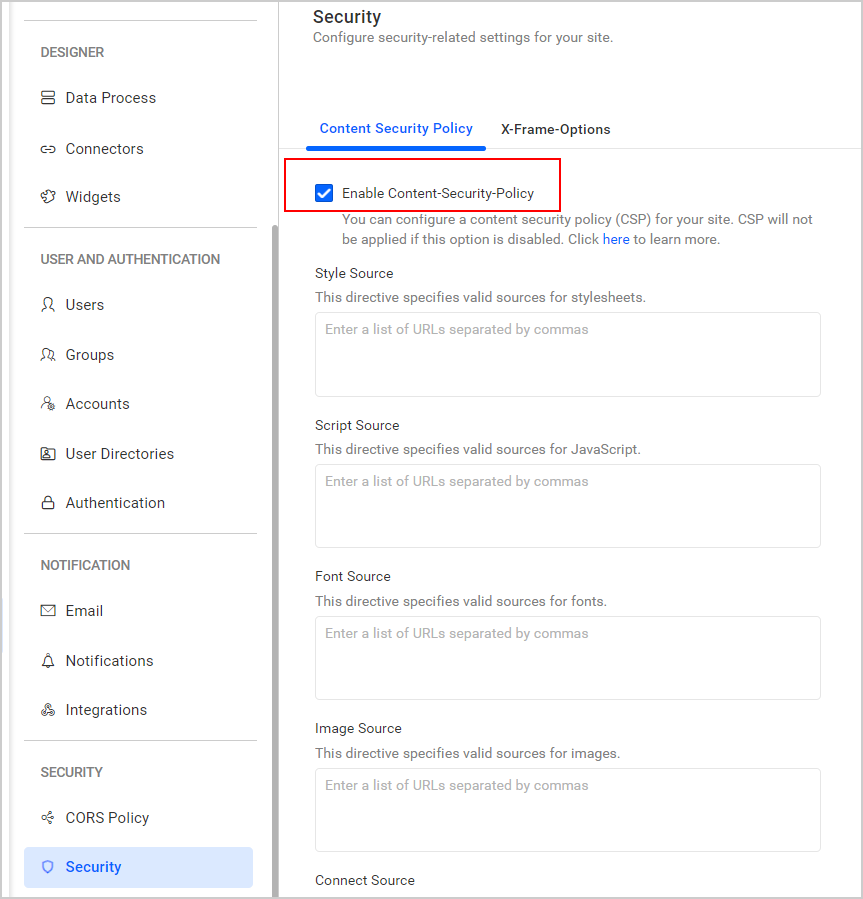Content Security Policy
An attacker may attempt to deliver malicious scripts and inject unwanted data into your site using cross-site scripting (XSS) and data injection attacks. The browser will execute all sources from any origin without restriction, as it does not know whether the source is trusted or not. The malicious script can then access any cookies, session tokens, or other sensitive information stored by the browser. Therefore, to protect your site from this type of attack, the Content Security Policy includes a standardized set of directives that guide the browser on which content sources are allowed and which should be restricted.
How it works?
The Content Security Policy uses the Content-Security-Policy response header to restrict resource loading from unknown domains and allows resources only from the configured list of domains for each source. To restrict the execution of malicious resources, including style, script, font, image, connect, and frame sources, from other domains on your site, configure the Content Security Policy with the specific directive in Bold BI.
Do enable Content Security Policy will affect existing dashboards rendering?
Enabling Content Security Policy (CSP) will not affect dashboard rendering unless the resources loaded inside the dashboards are requested from unknown domains, and URLs are not excluded from the CSP settings. If you want to load resources for your dashboard from an external URL, you need to add that URL in the respective sources section of the CSP settings.
To learn more about the areas that will be affected in dashboards when the Content Security Policy (CSP) is enabled in Bold BI.
Content Security Policy Configuration
Configure the Content Security Policy in the Security settings, which can be found under the Security section in the administration settings of Bold BI.
By default, the Content Security Policy is disabled, allowing sources from all domains without any restriction. The Content-Security-Policy response header will not be added to the request.

Enabling Content Security Policy
If you enable the Content-Security-Policy option, the Content-Security-Policy response header will be added to the request header with the default allowed domain values for each source.

Policy configuration for Style Source
The style-src directive allows only the style sheets from URLs that are added in the Style Source field and restricts style sheets from other URLs.

The permitted URLs will be added to the Content-Security-Policy for the style source.
Content-Security-Policy: style-src 'self' http://example.com
Policy configuration for Script Source
The script-src directive allows only JavaScript sources from URLs that are added in the Script Source field, and it restricts script sources from other URLs.

The allowed URLs will be added to the Content-Security-Policy for the script source.
Content-Security-Policy: script-src 'self' https://test.boldbi.com http://example.com
Policy configuration for Font Source
The font-src directive allows font sources only from URLs that are added in the Font Source field and restricts font sources from other URLs.

The permitted URLs will be added to the Content-Security-Policy for the font source.
Content-Security-Policy: font-src 'self' https://test.boldbi.com
Policy configuration for Image Source
The img-src directive allows only the images from URLs that are added in the Image Source field and restricts image sources from other URLs.

The permitted URLs will be added to the Content-Security-Policy for the image source.
Content-Security-Policy: img-src 'self' http://localhost:62833
Policy configuration for Connect Source
The connect-src directive allows the source to make Fetch/XHR requests only from URLs that are added in the Connect Source field and restricts sources that make Fetch/XHR requests from other URLs.

The permitted URLs will be added to the Content-Security-Policy for the connect source.
Content-Security-Policy: connect-src 'self' http://localhost:62833
Policy configuration for Frame Source
The frame-src directive allows the sources for the nested document to use elements such as <frame> and <iframe> only from URLs that are added in the Frame Source field, and it restricts sources from other URLs.

The permitted URLs will be added to the Content-Security-Policy for the frame source.
Content-Security-Policy: frame-src 'self' http://example.com
Policy configuration for Frame Ancestors
The Frame-Ancestors directive specifies valid parent domains that may embed a dashboard or complete application using <iframe> only from URLs added in the Frame-Ancestors field. However, the CSP header will not apply this directive if the X-Frame-Options has already been enabled.

The allowed URLs will be included in the Content-Security-Policy for the frame ancestors.
Content-Security-Policy: frame-ancestors 'self' http://example.com
- How it works
- Do enable Content Security Policy will affect existing dashboards rendering
- Content Security Policy Configuration
- Enabling Content Security Policy
- Policy configuration for Style Source
- Policy configuration for Script Source
- Policy configuration for Font Source
- Policy configuration for Image Source
- Policy configuration for Connect Source
- Policy configuration for Frame Source
- Policy configuration for Frame Ancestors
- How it works
- Do enable Content Security Policy will affect existing dashboards rendering
- Content Security Policy Configuration
- Enabling Content Security Policy
- Policy configuration for Style Source
- Policy configuration for Script Source
- Policy configuration for Font Source
- Policy configuration for Image Source
- Policy configuration for Connect Source
- Policy configuration for Frame Source
- Policy configuration for Frame Ancestors